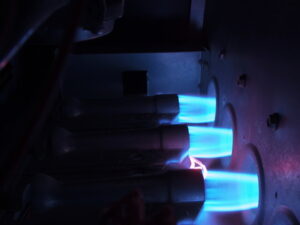
You might still have a furnace that uses a standing pilot light to ignite the burners, but this style of furnace ignition is fading away as improved technology takes over. Fewer new furnace models use standing pilot lights, and if the current furnace you have was built after 2010, then it almost certainly uses a different type of ignition system—an electronic one.
The year 2010 was when most natural gas furnaces shifted from standing pilot lights to types of electronic ignition. If you want to know how these ignition systems work, you’ve come to the right place.
Why Furnaces Shifted to Electronic Ignition
Why did the standing pilot light go out of favor? There are several reasons using electronic ignition is a better system, but the main one is that electronic ignition is more energy-efficient and less expensive than standing pilot lights.
A standing pilot has to remain burning throughout the winter season so the furnace can turn on when it needs to. This requires the furnace to continually burn gas whether it’s heating the house or not. The average pilot light consumes about 600 BTUs of energy per hour, which accumulates over a season. This can add up to paying $50 more per year to run the furnace. The change to electronic ignition meant there’s no need for a furnace to burn any gas when it’s not heating a home, and the cost of electricity to run electronic ignition systems is about $1 a year.
Hot Surface Ignition Systems
There are two types of electronic ignition systems found in furnaces today: hot surface and intermittent pilots. The first is the most common.
A hot surface ignition system works in a way similar to the filament in a lightbulb. Electric current passes through the ignitor, which is made of silicon nitride or silicon carbide ceramic. Through the process of electrical resistance, the ignitor glows hot. When the furnace receives a request for heating, it opens up the gas to the burners, then sends current to the ignitor. When the ignitor’s surface is hot enough, it ignites the gas. The ignitor then shuts off.
Intermittent Pilot Ignition Systems
You’ll notice the word pilot, but these systems don’t use standing pilot lights that remain burning. Instead, they light the pilot light for just long enough to ignite the burners and then shut it off.
The pilot assembly is similar to those in older furnaces, but gas only flows to the assembly when the furnace receives a request for heating: the gas to the burners and pilot come on at the same time. Then, an electronic spark lights the pilot light, and it, in turn, ignites the burners. When the furnace detects the burners are lit, it then shuts off the gas to the pilot assembly and the pilot light goes out until needed again.
Either ignition system can fail during the furnace’s life. In this case, the flame sensor will shut off gas to the burners as a safety precaution and the furnace won’t turn on. When this occurs, just call us for furnace repair in Loganville, GA. Usually, all we’ll need to do is replace the ignition system, which is a basic repair.
Experience the Premier Difference! Premier Heating & Air has been family-owned and operated since 2001.

